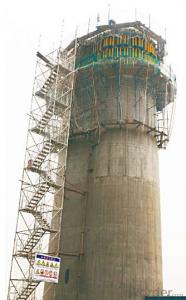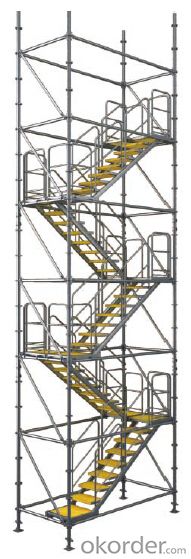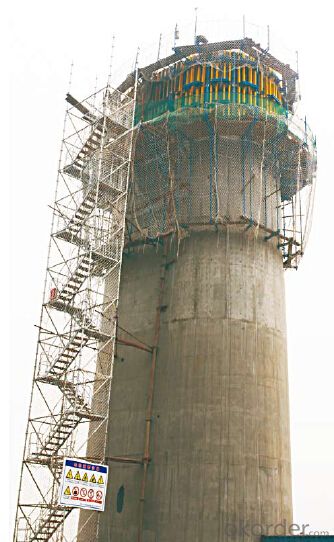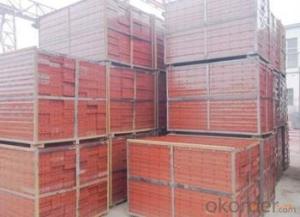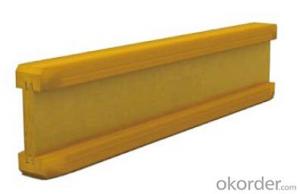Stair-Tower for Formwork and Scaffolding System
- Loading Port:
- Tianjin
- Payment Terms:
- TT OR LC
- Min Order Qty:
- 50 m²
- Supply Capability:
- 1000 m²/month
OKorder Service Pledge
Quality Product, Order Online Tracking, Timely Delivery
OKorder Financial Service
Credit Rating, Credit Services, Credit Purchasing
You Might Also Like
Stair Tower
The structure of ring-lock stair tower is the same as Φ60 ring lock scaffolding.
The dimension of cross section is 1500×3000mm.It is widely used in construction.
Bearing Capacity of Stair Tower:
The stair tower can be erected with the maximum height of 150m,
when attached to the wall every 4.5m.
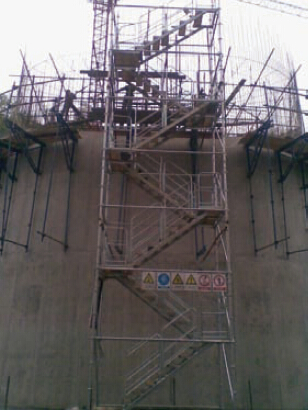

- Q: How do steel formwork systems ensure proper alignment and stability?
- Various features and design elements in steel formwork systems guarantee proper alignment and stability. To begin with, high-quality steel materials are used in the construction of these systems, ensuring exceptional strength and durability. This ensures that the formwork maintains its shape and structure even under heavy loads and adverse weather conditions. Furthermore, interlocking mechanisms and connecting devices are often incorporated into steel formwork systems to securely hold the formwork panels together. These connections provide a tight and precise alignment, preventing any movement or shifting during the concrete pouring process. In addition, adjustable components such as adjustable struts or props are typically included in steel formwork systems. These components allow for easy and accurate leveling and alignment, enabling workers to fine-tune the formwork to the desired position and ensure a level and uniform concrete surface. Moreover, diagonal bracing or cross-bracing elements are commonly incorporated into steel formwork systems to provide added stability and rigidity. These bracing elements help distribute the load evenly across the formwork, minimizing any potential sagging or deformation and ensuring the stability of the structure during the concrete pouring and curing process. Lastly, steel formwork systems are highly versatile and can be customized to fit various shapes and sizes. This flexibility allows for precise alignment to the desired form, guaranteeing that the concrete structure is constructed with the utmost accuracy and stability. In conclusion, steel formwork systems ensure proper alignment and stability through the use of high-quality materials, interlocking mechanisms, adjustable components, bracing elements, and customization options. These features combine to create a reliable and robust formwork system that guarantees the accurate and stable construction of concrete structures.
- Q: How does steel formwork affect the overall structural integrity of a building?
- The overall structural integrity of a building is heavily reliant on steel formwork. During the construction process, steel formwork is used as a temporary mold or framework to shape and support concrete until it hardens and gains enough strength to bear its own weight and other applied loads. One of the main benefits of steel formwork is its superior strength and durability in comparison to other types of formwork like wood or plastic. Steel possesses high tensile strength and resistance to deformation, enabling it to withstand the pressure exerted by wet concrete without significant distortion. This strength ensures that the formwork maintains its shape and stability throughout the pouring and curing of concrete, preventing any potential collapse or failure that could compromise the building's structural integrity. Moreover, the use of steel formwork delivers precise and accurate results in terms of dimension and shape, which is crucial for achieving the desired structural integrity. Steel formwork can be fabricated to exact specifications, allowing for tight tolerances and precise positioning of reinforcement, resulting in a more uniform and robust structure. This precision guarantees that the building can endure various external loads, such as wind, seismic forces, and live loads, without excessive deflection or deformation. Additionally, steel formwork offers excellent reusability, making it a cost-effective and sustainable choice for construction projects. Unlike other formwork types that may require frequent replacement, steel formwork can be used multiple times, reducing material waste and overall project costs. This reusability also contributes to the building's structural integrity, as the formwork is less prone to deterioration or degradation over time, ensuring consistent quality and performance. To summarize, steel formwork significantly enhances the overall structural integrity of a building by providing superior strength, precision, and durability. Its ability to withstand the pressure of wet concrete, maintain accurate dimensions, and resist external loads ensures the building's structural stability and safety. Furthermore, the reusability of steel formwork offers cost-effective and sustainable advantages, further contributing to the long-term structural integrity of the constructed building.
- Q: What are the fire resistance properties of steel formwork?
- Steel formwork has excellent fire resistance properties due to its high melting point and low thermal conductivity. It is able to withstand high temperatures for extended periods of time without losing its structural integrity, making it a safe and reliable choice for construction projects in fire-prone areas.
- Q: Can steel formwork be customized for specific project requirements?
- Customization of steel formwork is possible to meet the specific requirements of a project. Steel, being highly versatile, can be shaped and molded easily to fit the unique needs of a project. This flexibility allows for the creation of different sizes, shapes, and designs to accommodate varying construction needs. On-site modification or adjustment of steel formwork is also achievable to align with the exact dimensions and specifications of a project. Furthermore, off-site pre-fabrication of steel formwork, tailored precisely to the project's requirements, is an option before transporting it to the construction site. By customizing steel formwork, it becomes suitable for a wide range of construction projects, including intricate structures, tall buildings, bridges, tunnels, and more.
- Q: Are there any limitations or disadvantages of using steel formwork?
- There exist certain limitations and drawbacks associated with the utilization of steel formwork. One constraint pertains to the cost. Comparatively, steel formwork tends to be more expensive in comparison to alternative formwork types, such as wood or aluminum. Consequently, it may not be a practical choice for projects operating within tight budgetary constraints. Another limitation involves the weight and unwieldiness of steel formwork. Its substantial weight makes transportation and handling challenging, potentially necessitating additional equipment and labor. Moreover, the bulkiness can complicate the storage and stacking of the formwork when not in use. The assembly and disassembly of steel formwork also require skilled labor. Unlike certain formwork types like modular or reusable plastic formwork, steel formwork often necessitates custom-made fittings at the construction site. This can lead to increased labor costs and elongated construction timelines. Additionally, without proper maintenance, steel formwork is susceptible to corrosion. Exposing it to moisture, chemicals, and harsh weather conditions can result in rusting, thereby weakening the formwork over time. Regular inspections and maintenance are indispensable for ensuring the longevity and safety of steel formwork. Lastly, depending on the nature of the construction project, steel formwork may not be suitable. Its rigidity and lack of flexibility make it less adaptable to complex or irregular shapes. Consequently, alternative formwork materials or systems may prove more suitable in such instances. Despite these limitations and disadvantages, steel formwork also presents several advantages, including durability, reusability, and a high load-bearing capacity. Consequently, it is crucial to thoughtfully consider the project's specific requirements prior to making a decision on whether to employ steel formwork.
- Q: Can steel formwork be used for structures with high wind resistance requirements?
- Yes, steel formwork can be used for structures with high wind resistance requirements. Steel is a strong and durable material that can withstand the forces exerted by high winds. When used as formwork, steel provides a stable and rigid framework for pouring concrete, ensuring that the structure maintains its shape and integrity even under extreme wind conditions. Additionally, steel formwork can be designed and reinforced to meet specific wind load requirements, making it suitable for constructing buildings in areas prone to high winds or hurricanes.
- Q: How does steel formwork affect the construction schedule?
- The construction schedule can be significantly impacted by steel formwork. One of the main benefits of using steel formwork is its ability to provide a high level of stability and strength, enabling faster construction processes. This results in reduced overall construction time compared to traditional formwork methods. Moreover, steel formwork is highly durable and can be used multiple times, making it suitable for future projects. This reduces the time and cost associated with acquiring and assembling new formwork for each project, further enhancing the efficiency of the construction schedule. In addition, steel formwork allows for precise and accurate construction, resulting in a higher quality finished product. This minimizes the need for rework and corrections, ultimately saving time and ensuring that the project stays on schedule. Furthermore, steel formwork is known for its flexibility and adaptability. It can be easily adjusted and modified to accommodate design or construction changes. This promotes a smoother workflow and minimizes delays that may arise from design alterations. However, it is important to note that the initial setup and installation of steel formwork may require more time and resources compared to other formwork systems. The design and fabrication process for steel formwork can be more complex, necessitating careful planning and coordination. Therefore, it is crucial to consider these factors during the project planning phase to ensure that the construction schedule is not negatively affected. Overall, steel formwork can significantly expedite the construction schedule by offering strength, durability, precision, and adaptability. However, it is essential to thoroughly evaluate project requirements and available resources to optimize the use of steel formwork and minimize potential disruptions to the construction schedule.
- Q: Can steel formwork be customized to meet specific project requirements?
- Indeed, specific project requirements can be met by customizing steel formwork. This construction material, known for its versatility and flexibility, can readily be modified and adapted to accommodate various shapes, sizes, and dimensions. By cutting, welding, and reshaping it, the steel formwork can be tailored to meet the exact demands of a project. Moreover, its ability to create intricate and complex structures makes it well-suited for diverse construction endeavors. The customization options available with steel formwork empower builders and contractors to achieve precise and meticulous outcomes, guaranteeing that the final structure aligns with the desired specifications and design prerequisites.
- Q: What are the common safety training requirements for steel formwork installation?
- Common safety training requirements for steel formwork installation typically include: 1. Fall protection training: Workers must be trained on proper harness and fall protection equipment usage to prevent falls from heights during installation. 2. Hazard communication training: Workers should be educated on the potential hazards associated with steel formwork installation, such as heavy lifting, sharp edges, and potential collapse, and how to mitigate these risks. 3. Equipment operation training: Proper training on the use and maintenance of tools and equipment specific to steel formwork installation, such as cranes, hoists, and concrete pumps, is necessary to ensure safe operation. 4. Material handling training: Workers need to learn proper techniques for lifting, carrying, and placing steel formwork components to prevent injuries related to overexertion, strains, and sprains. 5. Structural stability training: Understanding the structural integrity of the formwork system and how to identify signs of instability or failure is crucial for ensuring worker safety during the installation process. 6. Emergency response training: Workers should receive training on emergency procedures, including evacuation plans, first aid, and the proper use of fire extinguishers, in case of accidents or incidents on the job site. These are some of the common safety training requirements for steel formwork installation, but specific regulations and additional training may vary depending on the country, industry standards, and project requirements.
- Q: Can steel formwork be used for staircase construction?
- Indeed, steel formwork is perfectly suitable for the construction of staircases. This versatile and resilient material is frequently employed in construction ventures, including staircase construction. It furnishes a robust and secure framework for pouring concrete and guarantees the meticulous and precise formation of the staircase. Moreover, steel formwork can be reused, rendering it a cost-effective option for repetitive construction procedures such as staircase construction. Furthermore, it offers adaptability in terms of design, enabling the creation of diverse staircase shapes and dimensions. In summary, steel formwork is an ideal selection for staircase construction due to its potency, durability, reusability, and design flexibility.
Send your message to us
Stair-Tower for Formwork and Scaffolding System
- Loading Port:
- Tianjin
- Payment Terms:
- TT OR LC
- Min Order Qty:
- 50 m²
- Supply Capability:
- 1000 m²/month
OKorder Service Pledge
Quality Product, Order Online Tracking, Timely Delivery
OKorder Financial Service
Credit Rating, Credit Services, Credit Purchasing
Similar products
Hot products
Hot Searches
Related keywords

